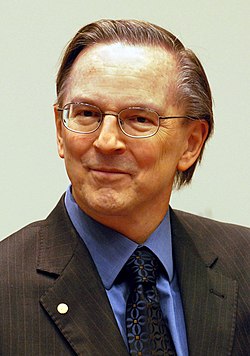Jack Szostak
Jack William Szostak (London, November 9, 1952) is an Anglo-American biologist who was raised in Canada.[1] Szostak is Professor of Genetics at Harvard Medical School. He shared the Nobel Prize in Physiology or Medicine in 2009 for the discovery of how chromosomes are protected by telomeres. His co-winners were Elizabeth Blackburn and Carol Greider. Szostak is also credited with the construction of the world's first yeast artificial chromosome.[2][3][4]
Jack William Szostak | |
|---|---|
 | |
| Born | November 9, 1952
(aged 73) |
| Occupation | molecular biologist |
| Known for | Nobel Prize in Physiology or Medicine in 2009 |
His lab has moved on to working on RNA. "By the year 2000, I started to pay more attention to fundamental questions related to the origin of life" (RNA world hypothesis).[5] "Here the big question is whether RNA was in fact the first genetic polymer, or whether RNA was preceded by some simpler, easier to make or more robust genetic material".[1][6] Recent work suggests that the RNA hypothessis is still alive.[7][8]
References
- ↑ 1.0 1.1 "Jack W. Szostak - Autobiography". nobelprize.org. 2011. Retrieved 25 February 2011.
- ↑ Orr-Weaver, T.L; Szostak J.W. & Rothstein R.J. 1981. Yeast transformation: a model system for the study of recombination. Proc. Natl. Acad. Sci. USA 78:6354–6358.
- ↑ Szostak J.W. et al 1983. The double-strand-break repair model for recombination. Cell 33:25–35
- ↑ Lundblad V. and Szostak J.W. 1989. A mutant with a defect in telomere elongation leads to senescence in yeast. Cell 57:633–643
- ↑ http://exploringorigins.org/ Exploringorigins.org
- ↑ Szostak J.W; Bartel D.P. & Luisi P.L. 2001. Synthesizing life. Nature, 409:387–390.
- ↑ Powner M.W; Gerland B. & Sutherland J.D. 2009, Synthesis of activated pyrimidineribonucleotides in prebiotically plausible conditions. Nature 459:239
- ↑ Schrum J; Ricardo A; Krishnamurthy K; Blain J.C. and Szostak J.W. 2009. Efficient and rapid template-directed nucleic acid copying using 2'-amino-2', 3'-dideoxyribonucleoside-5'-phosphorimidazolide monomers. J. Am. Chem. Soc. 31, 14560–14570